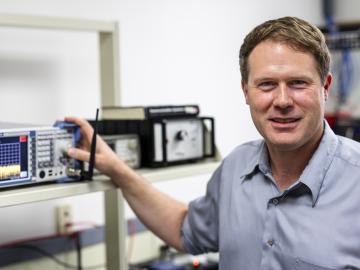
Filter News
Area of Research
- Biology and Environment (6)
- Computer Science (2)
- Electricity and Smart Grid (3)
- Energy Science (42)
- Fuel Cycle Science and Technology (1)
- Functional Materials for Energy (1)
- Fusion and Fission (2)
- Isotopes (1)
- Materials (8)
- Materials for Computing (1)
- National Security (40)
- Neutron Science (2)
- Quantum information Science (1)
- Sensors and Controls (1)
- Supercomputing (13)
News Topics
- (-) Grid (74)
- (-) National Security (86)
- 3-D Printing/Advanced Manufacturing (146)
- Advanced Reactors (40)
- Artificial Intelligence (131)
- Big Data (79)
- Bioenergy (112)
- Biology (128)
- Biomedical (73)
- Biotechnology (39)
- Buildings (74)
- Chemical Sciences (86)
- Clean Water (33)
- Composites (35)
- Computer Science (226)
- Coronavirus (48)
- Critical Materials (29)
- Cybersecurity (35)
- Education (5)
- Element Discovery (1)
- Emergency (4)
- Energy Storage (114)
- Environment (218)
- Exascale Computing (67)
- Fossil Energy (8)
- Frontier (64)
- Fusion (66)
- High-Performance Computing (130)
- Hydropower (12)
- Irradiation (3)
- Isotopes (62)
- ITER (9)
- Machine Learning (68)
- Materials (157)
- Materials Science (158)
- Mathematics (12)
- Mercury (12)
- Microelectronics (4)
- Microscopy (56)
- Molten Salt (10)
- Nanotechnology (64)
- Neutron Science (171)
- Nuclear Energy (122)
- Partnerships (68)
- Physics (69)
- Polymers (35)
- Quantum Computing (53)
- Quantum Science (92)
- Security (31)
- Simulation (65)
- Software (1)
- Space Exploration (26)
- Statistics (4)
- Summit (71)
- Transportation (103)
Media Contacts

Researchers are using machine learning to provide a more complete picture of building geometries that include building height to within three meters of accuracy. This model not only provides building height for any building in the world, but it will also feed into LandScan and other large government datasets for planning and response.

In early November, ORNL hosted the International Atomic Energy Agency (IAEA) Interregional Workshop on Safety, Security and Safeguards by Design in Small Modular Reactors, which welcomed 76 attendees representing 15 countries, three U.S. national labs, domestic and international industry partners, as well as IAEA officers.

From during his early years at NASA to his current role a researcher and group leader, Peter Fuhr has pushed the boundaries of optical and sensor technology. Fuhr’s path is marked by wacky creativity that can’t confine itself to challenges in a single field. No idea is too far out to try out — and so many of them work that Fuhr has a host of inventions and start-ups under his belt.

Joel Brogan, who leads the Multimodal Sensor Analytics group at Oak Ridge National Laboratory, has been elevated to senior membership in the Institute of Electrical and Electronics Engineers.

The Powerline Conductor Accelerated Testing Facility at ORNL is testing new transmission line technologies to enhance the U.S. power grid's capacity amidst rising demand and climate challenges.

Aditya Sundararajan of ORNL’s Grid Systems Architecture group was elevated to senior status within the Institute of Electrical and Electronics Engineers.

The Department of Energy’s Office of Electricity, in partnership with ORNL, has launched an experimental platform for energy sector-related data with enhanced emphasis on governance and usability.

ORNL researcher Corey Cooke investigates challenges in radar, digital signal processing and communications systems while serving as a joint faculty member at Tennessee Tech, teaching online courses and advising graduate students to create a pipeline for new researchers to the lab and support the growth of current staff.

ORNL and NASA co-hosted the fourth iteration of this invitation-only event, which brings together geospatial, computational, data and engineering experts around a theme. This year’s gathering focused on how artificial intelligence foundation models can enable geospatial digital twins.

A new technical collaboration program at the Department of Energy’s Oak Ridge National Laboratory will help businesses develop and launch electric grid innovations. Sponsored by the Transformer Resilience and Advanced Components program in DOE’s Office of Electricity, the initiative will provide companies with access to national laboratory resources, enabling them to capture market opportunities.


